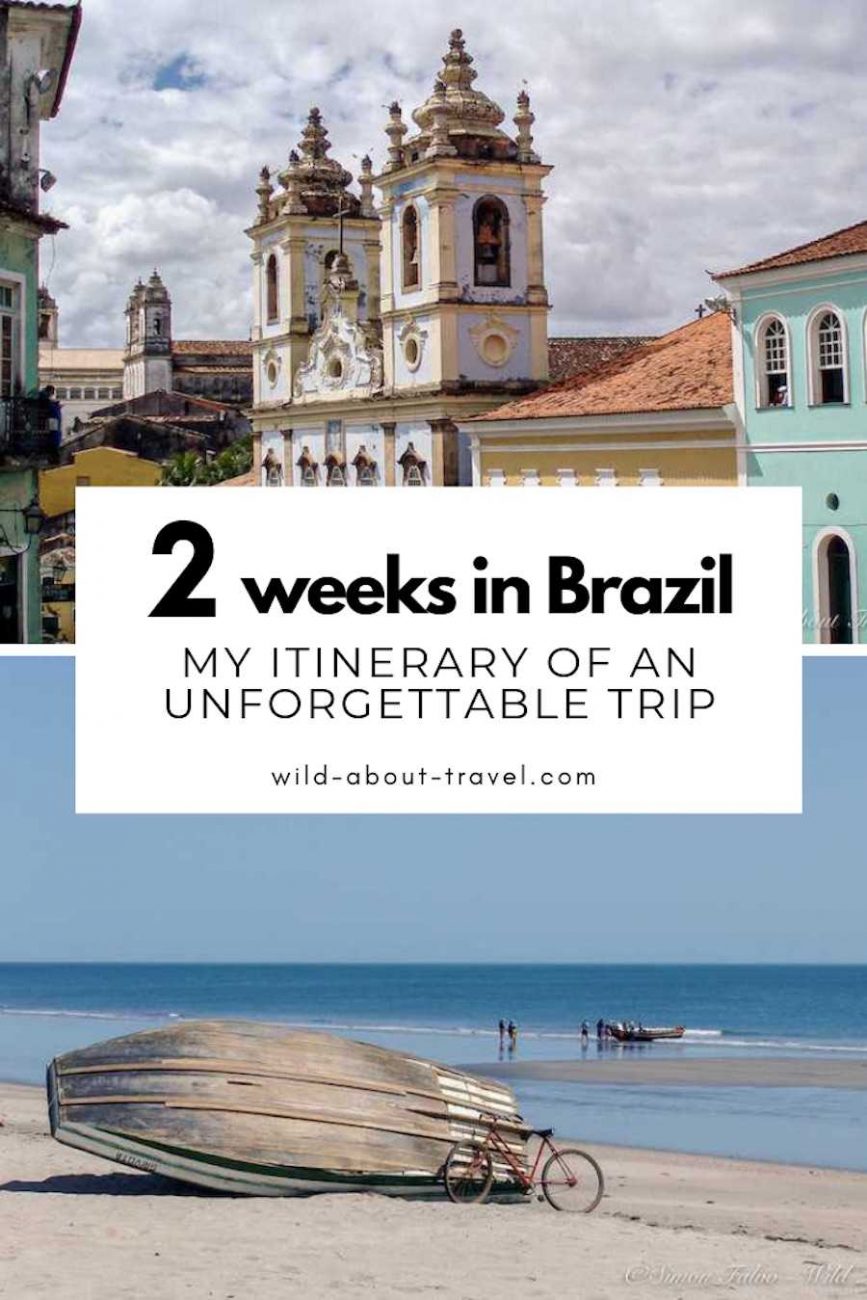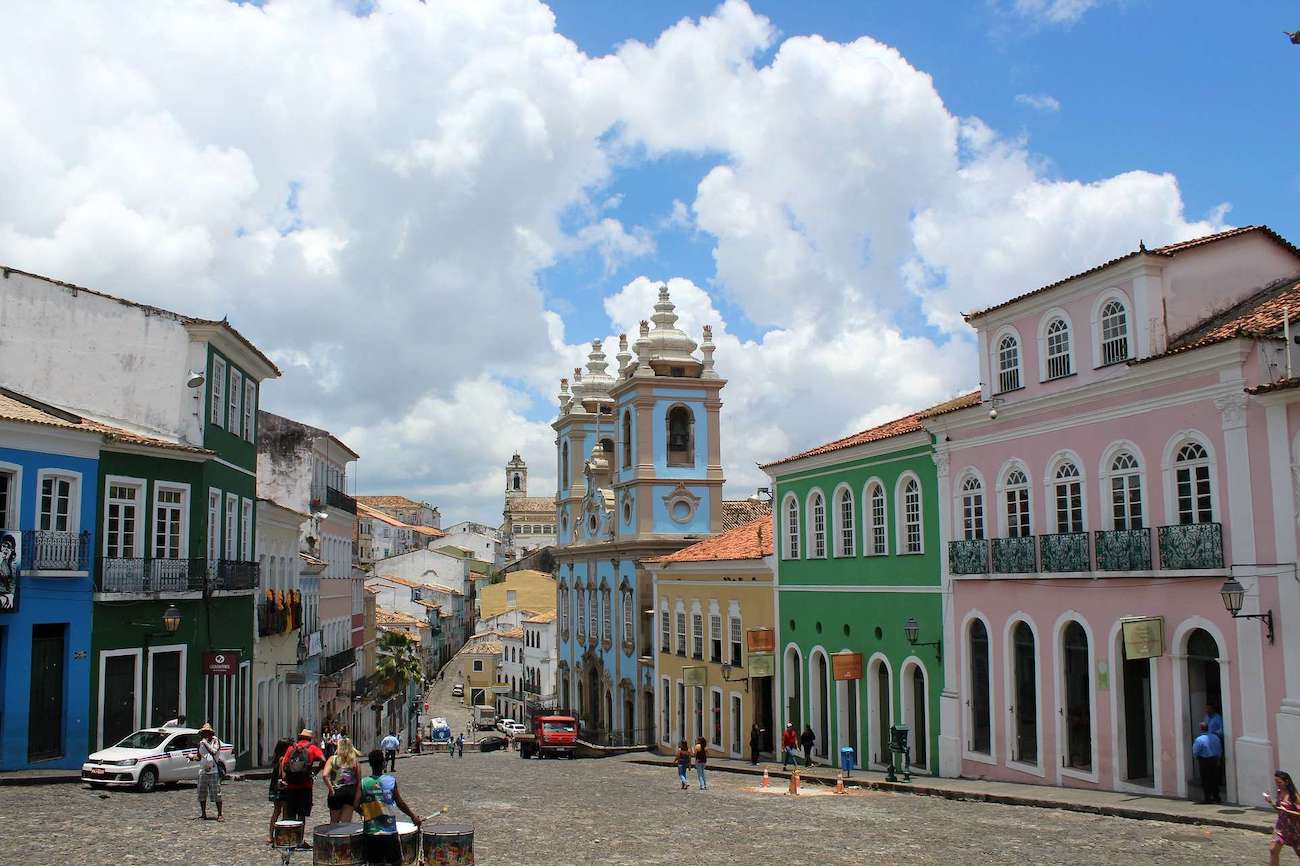It’s the 5th largest country in the world, and 2 weeks in Brazil is barely enough to scratch the surface. Expecting to see it all in a short time is unrealistic. You have to decide beforehand which are Brazil’s famous landmarks you don’t want to miss. And from there, build your trip. Read about my Brazil itinerary to some of the most beautiful places.
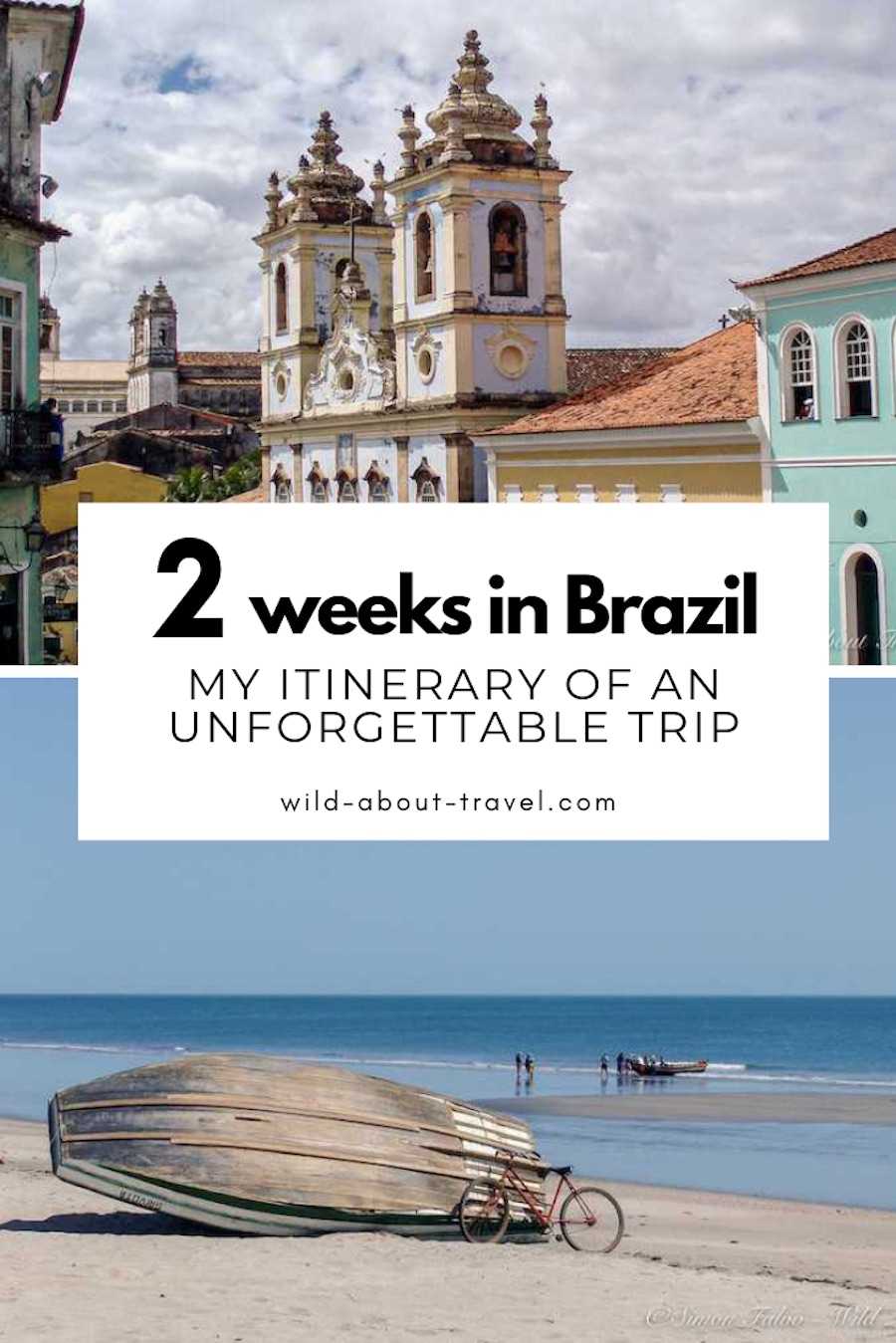
I usually like to leave a considerable amount of improvisation in my travels, but when I eventually decided to have a vacation in Brazil, I soon found out that accurate planning was more than an option. It was a necessity.
Brazil is a vast and diversified country, and since I had only a limited time, I did a lot of background research. First, I read the Lonely Planet Brazil Guide and the Rough Guide to Brazil. Then I studied the itineraries of good tour operators. At that point, I wrote down a list of the places that were on the top of my wishlist. From there, I looked into how to hop from one spot to the other, how much it would take, and the costs.
Once gathered all the preliminary information, I started to draw my Brazil itinerary, trying to find the right balance to see as much as possible of Brazil in 2 weeks without rushing too much.
Planning a trip to Brazil
Getting to Brazil
Whatever country you’re traveling from, you’re likely to take a flight to Sao Paolo or Rio de Janeiro. Among Brazil’s busiest airports for international travelers, you’ll also find Recife and Fortaleza in the northeast. The flight cost can vary significantly depending on the season, and I generally check the schedules and prices on Kiwi.com to find the best bargains.
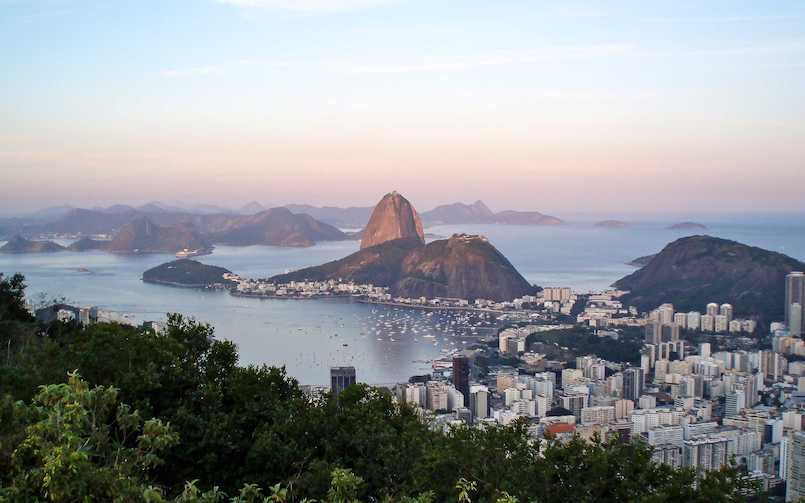
Travelers from the EU and many countries in South America don’t need a Visa. Brazil has recently granted access also to citizens from the United States, Canada, Australia, and Japan without a Visa.
That means that it’s now easier to travel to Brazil, and as a result, many airlines increased direct flights. Having said that, since things can change over time, it’s always better to check what are the latest requirements on an official source.
Getting around in Brazil
Brazil is incredibly vast, and rainforests cover a good portion of the country. Like in most countries in Latin America, there are virtually no railways, and getting around in Brazil by bus is an option only if you have a lot of time. Therefore, if you can only spend 2 weeks in Brazil, flying is the most effective way to visit the country, if not the only one.
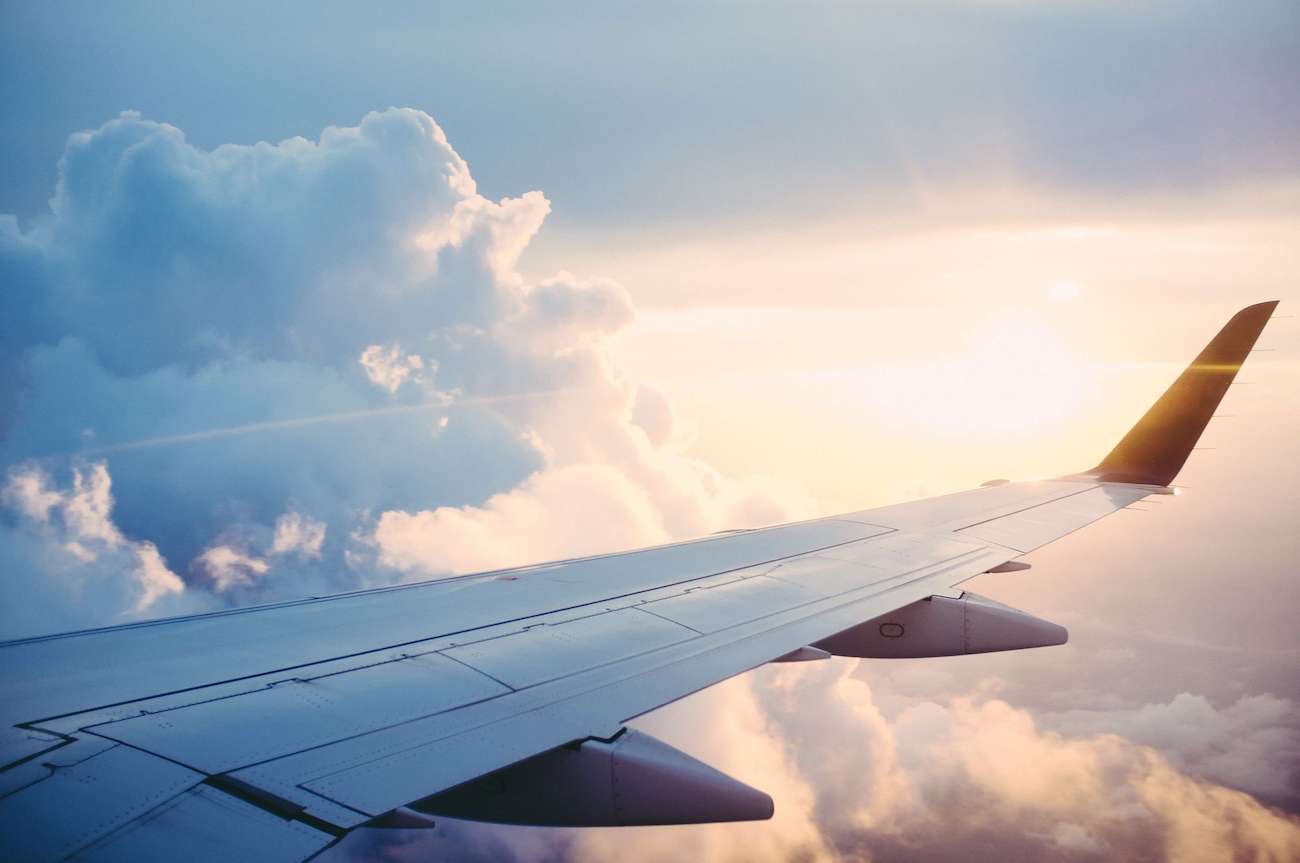
Having to rely on many domestic flights in Brazil to get around is one of the main reasons why you need to plan your itinerary carefully. With only two weeks in Brazil, you don’t want to get stuck because there are no seats left.
Best time to visit Brazil
Spanning from the equator to under the tropic of Capricorn, and occupying a wide surface inland, Brazil’s climate varies widely depending on the geographic area. In general terms, a good portion of the country has a tropical climate. Meaning that the most significant differences are in terms of humidity and average rainfalls.
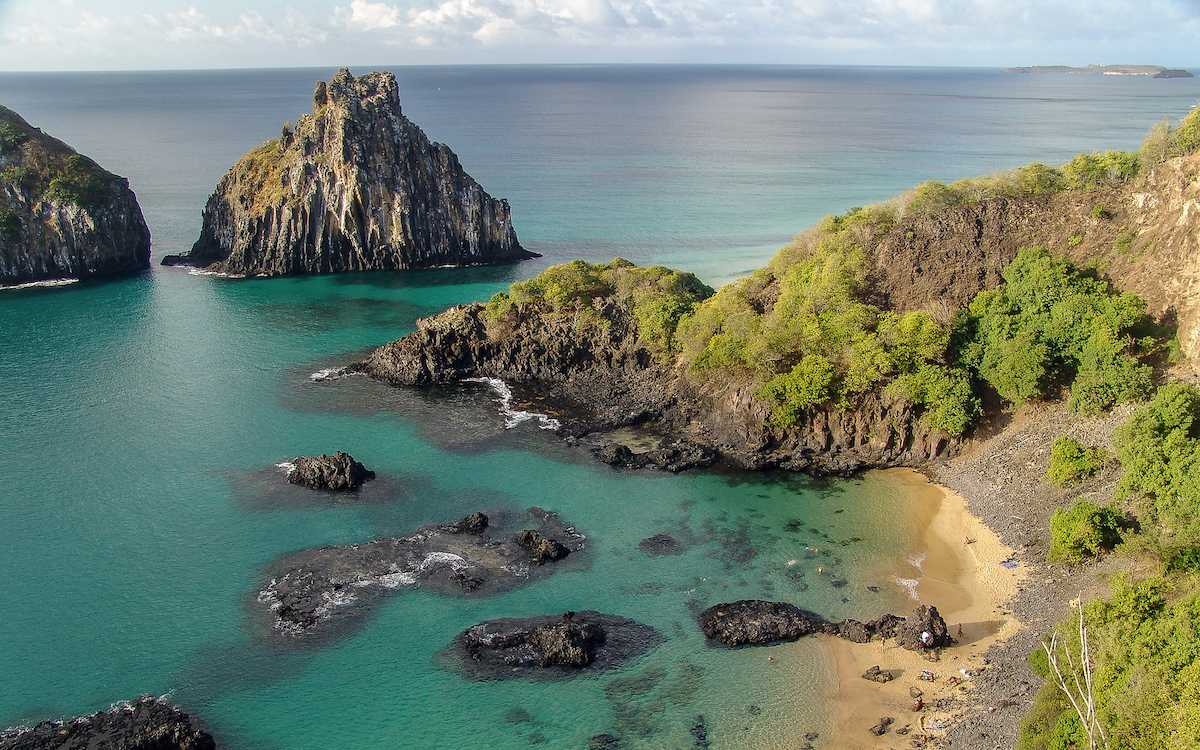
Furthermore, unlike Argentina or Peru, there are no high mountains in Brazil. That means that with a few exceptions temperatures never get very low. There are only a handful of areas where the temperature gets to freezing levels, and not often. Hence, you likely won’t need ultra-warm clothes in Brazil, even if you visit during the local winter months!
➣ Rio de Janeiro: the months from December to February, which is Summer in the Southern hemisphere, are the hottest months. Temperature can reach 40°C (104°F), and January is quite wet, with frequent and possibly abundant rainfalls. Summer is also high season and Carnival time. Subsequently, it’s more crowded and expensive. Winter in Brazil is mild, and while you might not be able to sunbathe and swim, it’s enjoyable. June, July, and August is the best time to visit Rio de Janeiro if you want to avoid the crowds and don’t want to endure scorching heat.
➣ Salvador de Bahia: generally hot and humid, the temperature in Salvador de Bahia is warm almost all year. However, if possible try to avoid April to June, the months with the most abundant rainfalls and a high level of humidity.
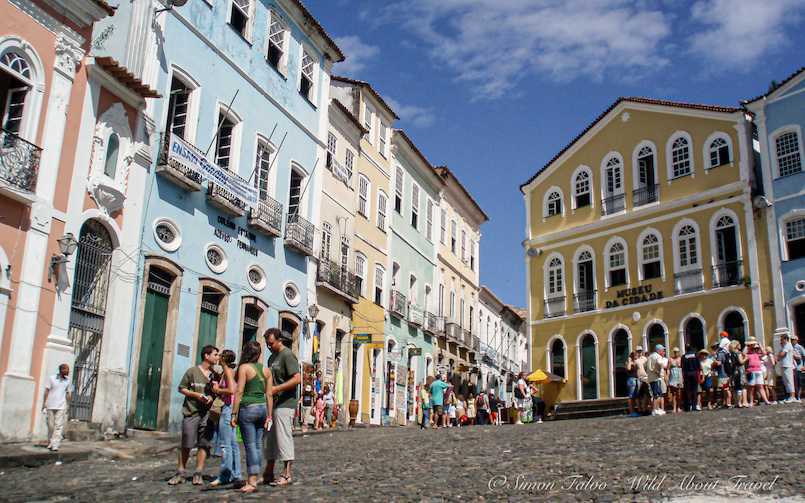
➣ Iguazu Falls: you can travel there all year round. However, you should keep in mind a few factors. Summer, from December to February, is when the water levels are at their peak. While this certainly promises gorgeous views, it’s also peak season (meaning more crowded and pricey). Furthermore, these are the rainiest months. Seeing the falls at full capacity comes at a price!
Thus, the best time to visit Iguazu Falls is generally from March to the end of September. Temperatures are more comfortable, there are fewer rainfalls (although I had a few short showers in August), and it’s less crowded.
➣ Cearà, Maranhao, and Lençois de Marnhenses: although the northeast of Brazil is hot all year, it has a typical tropical climate. That’s why the best time to visit Cearà, Maranhao, and discover the fantastic Lençois de Marnhenses is from May to August. After that, the beautiful lagoons will dry, and you’ll miss all that makes them such a special place.
➣ Brazil Amazon rainforest: due to the equatorial climate, with constant rainfalls throughout the year, you can visit the Brazil rainforest all year round. However, keep in mind that the most torrential rains usually occur from December to May. Therefore, in relative terms, the best time to visit the Amazon is from June to November.
Independent travel or organized tour?
Whenever possible, I favor independent travel, and I planned my Brazil itinerary on my own. Actually, if you think of independent travel vs. organized tours, there are pros and cons to both. In the end, you have to choose what you feel more comfortable with.
For sure, Brazil is one of those destinations where traveling on your own requires a lot of planning beforehand. Thus, if you don’t have much time or don’t enjoy preparing for a trip, a Brazil tour package is the perfect option. It will indeed make your trip to Brazil easier and smoother, and it’ll take long research off your shoulder. Someone else, more experienced, will take care of that, and you’ll focus on having the most memorable vacations in Brazil.
Brazil is a popular destination, and there are plenty of tour operators organizing beautiful trips. If I were to go back to Brazil on an organized tour, I would travel with either GAdventures or Intrepid Travel. They’re the tour operators that better reflect my travel style: small groups, responsible travel, nature, adventure, and cultural immersion. In case you want to get a comprehensive overview of Brazil travel packages from a wide number of tour operators, check out Tourradar.
Cost of travel in Brazil
Without a doubt, traveling to Brazil is expensive. There are many reasons for that. First, unless you visit a specific region, you’ll have to fly to get around. For example, my Brazil itinerary covered such a wide area that I had to buy multiple domestic flights to get around. Then, the prices fluctuate quite often, depending on the political and economic situation at the time of your travel. Furthermore, Brazil is beautiful but indeed not the safest country. That means that in the main cities, you need to choose the areas where to stay carefully. In short, you’ll have to arrange accommodations in touristy areas, which are safer but also more expensive.
Even if you travel independently, you’ll undoubtedly book a few guided tours to visit the cities, as well as to explore areas which you can’t reach on your own. Whether you go on a full-day tour of Rio de Janeiro’s main attractions or want to visit Iguazu Falls, including a boat ride, it all adds up.
Brazil is a stunning and fascinating country, and I loved every moment of my journey, but it’s also one of the most expensive trips I ever made.
Safety in Brazil
There’s a high rate of poverty in Brazil, and as a consequence, petty crime is common, especially in the big cities. For that reason, you need to be extra cautious and aware of your surroundings. Here are a few tips that can help you stay safe in Brazil:
- Keep a low profile appearance and avoid wearing jewelry, expensive watches, and other costly items.
- Don’t show off your camera
- Never leave your stuff unattended, especially when on the beach
- Beware of locals approaching you. They might have the best intentions, but that’s not always the case.
- Do some research, and stay in areas that are safe for tourists, even if they’re more expensive.
- Bring with you only the cash you need. Leave your passport at your hotel and carry a photocopy.
- Don’t walk around after dusk. If you plan a night out, catch a taxi.
- Stick to official taxis.
- Consider booking a private transfer from Sao Paulo Airport or Rio de Janeiro Airport to your hotel upon arrival.
Travel Insurance
Purchasing proper travel insurance and protecting yourself against possible adverse events (illness, theft, injury, cancellations, and more) is a must. If you don’t have one already, I suggest you look at Travelex insurance programs.
What to pack for a trip to Brazil
How to pack for a trip to Brazil depends on your itinerary and the time of the year. Keep in mind that it never gets frigid, so you won’t need anything too warm. Generally speaking, the best thing is to travel light and pack comfortable clothes and shoes, plus something more nice-looking if you fancy a night out.
Since it rains regularly, I strongly recommend comfortable, quick-dry pants and shirts, as well as a lightweight rain jacket with a hood. And don’t forget to pack an all-in-one universal travel adapter with USB ports to recharge your devices.
To avoid buying countless water bottles, I strongly recommend buying a filtered water bottle and a water purifier. It’s an excellent way to reduce plastic usage, and it won’t take long to write off the expense. I used them when I traveled to Pakistan, and they work like a charm.
2 weeks in Brazil: my itinerary
Brazil is such a vast country that it’s just impossible to visit it all in only 2 weeks. Hence, I built my Brazil itinerary focusing on the areas that most attracted me, knowing that I needed to make choices. First, I was curious to visit the lively Rio de Janeiro and experience the charm of Salvador de Bahia. I also wished to explore some wilder, off-the-beaten-track places like the Parque do Lençois and Fernando de Noronha. After having studied the distances and the flights, I was able to draw my ‘perfect’ itinerary, resulting in one of the most beautiful trips I made in recent years. Here’s what my Brazil two weeks itinerary looked like.
1 – Rio de Janeiro
I didn’t have much luck in Rio de Janeiro, and it’s a city where I would undoubtedly like to go back. Due to a delay, I missed my connection in Madrid and ended up arriving one day later than planned. Furthermore, the weather was not very good, preventing me from fully enjoying the Rio iconic view of the bay from the Corcovado. Notwithstanding, I liked the city a lot and managed to visit, if not all, at least many of Rio de Janeiro tourist attractions.
Unmissable Rio de Janeiro tourist attractions
If you’re spending 2 or 3 days in Rio de Janeiro, you’ll be able to visit the main attractions.
It’s no secret that the best things to do in Rio include the Sugarloaf mountain, from where if you’re lucky with the weather, you’ll admire one of the most iconic and breathtaking views in the world. You won’t want to miss the statue of Christ the Redeemer, dominating from atop the Corcovado, which is one of Rio de Janeiro landmarks that are a must-see. From atop the Corcovado, another spellbinding panoramic view awaits you.
The famous Copacabana beach is on everyone’s Rio de Janeiro wish list. If you have the time, though, also stroll along Ipanema beach. Remember the song “the Girl from Ipanema“?
Don’t miss visiting the bohemian neighborhood of Santa Teresa, which retained its colonial charm. Have dinner at one of the local restaurants, and end the night by listening to live music at one of the lively bars.
How about one or two Rio de Janeiro tours?
Although I’m a solo and independent traveler, there are times when I take a guided tour, especially in selected destinations. For sure, if you’re short of time, there’s no better way to discover Rio de Janeiro than an escorted tour. All the most since the city is enormous, and getting around is not always easy.
Here’s a selection of great Rio de Janeiro guided tours:
- Full-Day in Rio with Christ the Redeemer, Sugarloaf, Maracana and Selaron
- 6-Stop Highlights of Rio with Lunch
- Christ the Redeemer Early Access with Sugarloaf Mountain
- Rio de Janeiro: Sugar Loaf & Corcovado Private Day Tour
- Corcovado, Sugarloaf Mountain, and Selarón Steps 6-Hour Tour
- Santa Teresa & Lapa With Tram Ride And Selarón Steps
- Rio de Janeiro 30-Minute Highlights Tour by Helicopter
- Rio: Historical Walking Tour
- Favela Santa Marta Tour with a Local Guide
Unusual things to do in Rio de Janeiro
There is so much to do in Rio that you could easily spend a week or even more. However, you’ll have to make difficult choices if you can only spend 2 weeks in Brazil. Considering the mammoth distances, you’ll hardly stay more than 3 days in Rio de Janeiro. Having said that, if you’d like to combine sightseeing with exciting activities, active travel, or unusual things to do in Rio, here are some suggestions for you:
- Panoramic helicopter flight to admire Rio de Janeiro’s main attractions from the sky
- Rio de Janeiro: Small Groups Bike Tour
- Tijuca National Park 5-Hour Small-Group Hike to Pedra Bonita
- Pedra do Telégrafo Hike and Beach Full-Day Tour
- 3-Hour Sailing Trip on Guanabara Bay
- Vidigal Favela and Two Brothers Hike
- Rio de Janeiro Hang Gliding Adventure
- Paragliding Tandem Flight
- Speed Boat Tour in Angra dos Reis and Ilha Grande
Where to stay in Rio de Janeiro
➣ Rio Panoramic is a lovely B&B in the charming Santa Teresa neighborhood. The rooms are tastefully decorated, but the real treat is the amazing view of Guanabara Bay.
➣ Miramar Hotel by Windsor is a beautiful hotel overlooking Copacabana. The hotel features elegant contemporary rooms, a pool, and a gym.
➣ Modern and stylish, the JANEIRO Hotel is located in Leblon. The hotel faces the beach, offers breathtaking views from the rooftop terrace, and is only a 5-minute walk from the subway station.
Check more accommodations in Rio de Janeiro
2 – Iguazu waterfalls
Although quite a detour from the rest of the itinerary, which was heading me to explore the North-West of Brazil, I wanted to see the iconic Iguazu waterfalls. I couldn’t even imagine visiting Brazil and not getting to one of the most famous natural wonders in the world.
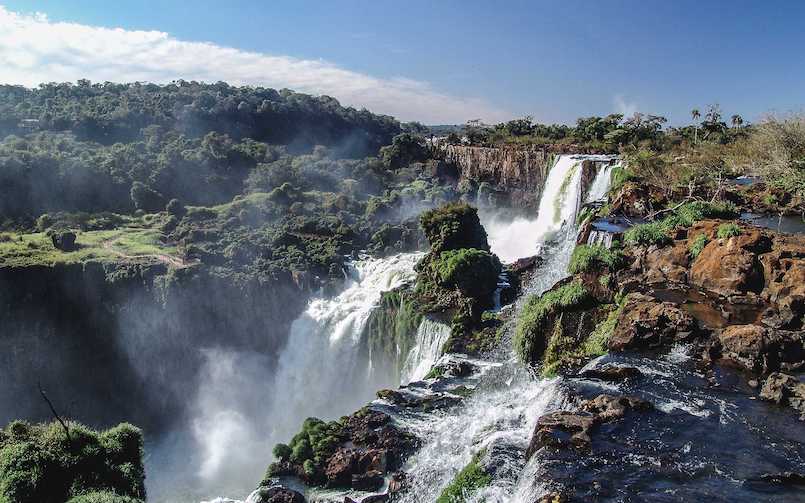
A UNESCO World Heritage site, the Iguazu falls stretch between Argentina and Brazil, providing two different experiences and places. For that reason, I decided to visit both the Brazil and Argentina sides of Iguazu National Park, and I heartily recommend you do the same if you get the chance.
How to visit Iguazu Falls
Regular flights connect Iguazu to Rio de Janeiro and Sao Paulo. Iguazu is a consolidated, well-organized tourist spot that you can easily visit independently. However, a guided tour might be the right choice if you only spend one day and still want to visit both sides. Nevertheless, I suggest you stay at least one night, and even better two, to dedicate a full day to each side and enjoy the many activities.
Even if you decide to focus on one of the two sides (and in that case, I recommend Argentina), a tour will save you the hassle of reaching the Iguazu National Park by public transportation. As a matter of fact, there’s only one luxury hotel inside Iguazu National Park. Therefore, you’re most likely to overnight in Foz de Iguazu, some 13 km (8 mi) from the entrance of the Park. If you book a guided excursion, they’ll pick you up and drop you off at your hotel.
Tip: When looking for information beware that the towns on the Argentinian and Brazilian sides have similar names and it’s easy to get confused. Foz de Iguazu = Brazil / Puerto Iguazu = Argentina.
Aside from walking around, don’t miss taking a boat tour to admire the waterfalls from a different angle. I also explored Iguazu by bike, which I loved and really recommend if cycling is your thing.
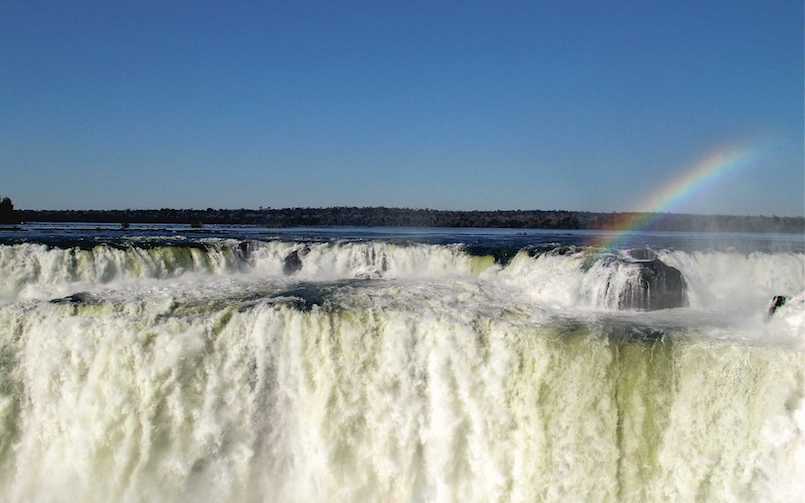
Here are a few selected Iguazu falls tours to you may want to check:
Brazilian Side
- From Foz do Iguaçu: Brazilian Iguazu Falls with Boat Ride
- Guided visit, with optional Helicopter Ride Over the Iguazu Falls
- If you have a passion for birds, check out the Bird Park Tour with Tickets
Argentina Side
Argentina+Brazil Sides
- 3-Day Iguazu Falls Exploring Tour
- Iguazu Falls: Visit the Argentinian and Brazilian Side in two days
TIP: Don’t forget to bring with you a waterproof poncho since, sooner or later, you’ll get more or less wet. Also, I strongly advise using a dry bag to protect your camera from water.
Where to stay in Iguazu
➣ As I mentioned before, there’s only one hotel inside the Brazilian side of Iguaçu National Park, the luxury Belmond Hotel das Cataratas. It’s obviously pricey, but you’ll also enjoy the unique experience of Iguazu Falls without the crowds early in the morning and at night.
➣ JL Hotel by Bourbon in Foz de Iguazu features modern and elegant rooms, an outdoor swimming pool, and a gym, and is good value for money.
3 – Salvador de Bahia
In Salvador de Bahia, I found everything I had imagined about Brazil after reading Jorge Amado’s ‘Dona Flor and her two husbands.’

My time in Rio de Janeiro was way too short, and while I liked the city a lot, I felt I missed the chance to fully appreciate it. Conversely, Salvador de Bahia stole my heart. In a matter of minutes, I fell in love with the pastel-colored houses of the Pelourinho – the historic center of Salvador de Bahia and a UNESCO World Heritage Site.
The ubiquitous music wrapping Salvador made the city one of the most joyful I have ever visited and reminded me of Cuba. Everywhere, an explosion of colors, and wide smiles. And I could never have enough of the incredible Bahia cuisine. Every dish was indeed delicious, but none as mouth-watering as the traditional Moqueca, a delicious fish stew mixed with African influences.
Things to do in Bahia
There’s no better way to discover Salvador de Bahia than getting lost in the alleys and enjoying the unique vibe of this fascinating city. Once you have explored the Pelourinho, I suggest you visit Mafro, the Museum of the Afro-Brazilian culture, to learn about the different influences that shaped the area of Salvador de Bahia.
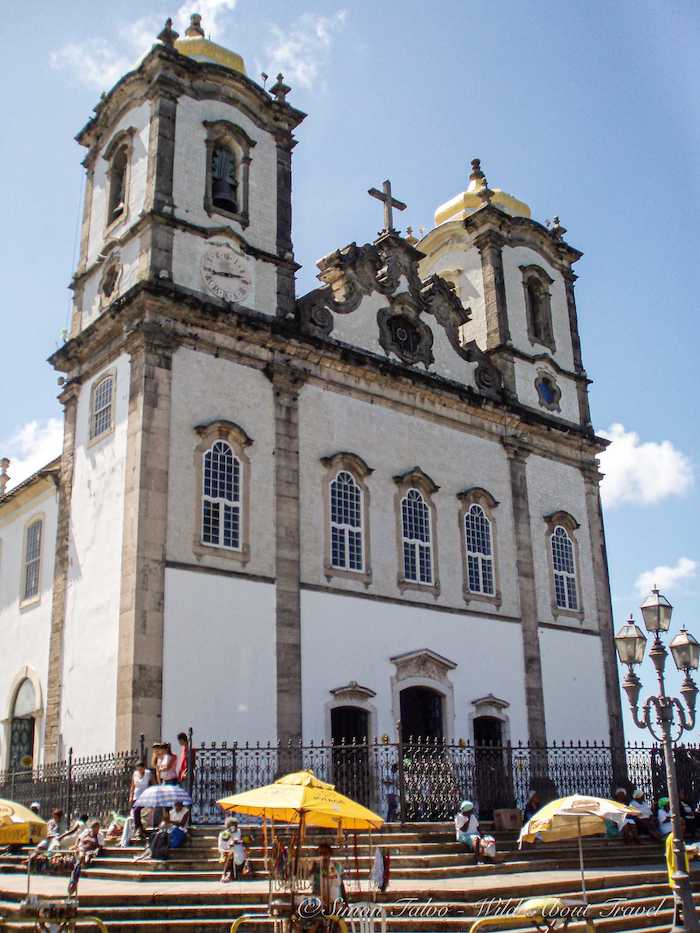
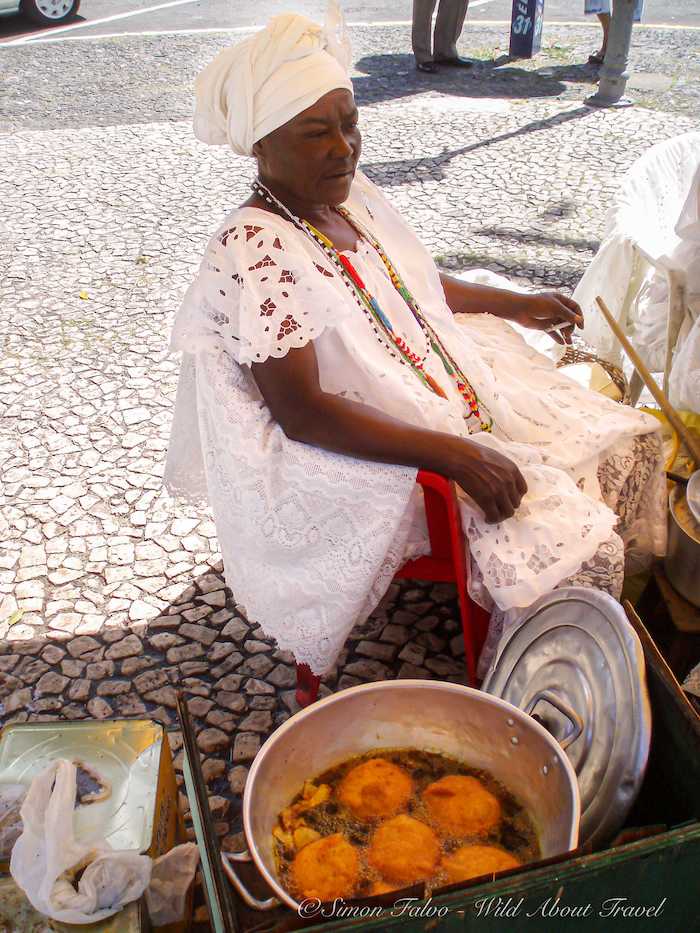
One of Salvador de Bahia attractions not to miss is the church of Nosso Senhor do Bonfim. Even if you’re not a fan of religious buildings, Bonfim is quite a unique experience. The veneration surrounding this church is incredible and palpable already outside, where you’ll see towering stacks of colorful bracelets sold as amulets. But it’s indeed inside the church, in the Chamber of Miracles, that you’ll fully get a sense of Bonfim. Hanging legs, arms, and other organs, made of plastic and walls entirely covered by passport photos tell stories of hope for a miracle. I never experienced a place like this, and it will long stay impressed in my memories.
Sightseeing in Salvador de Bahia on your own is not an issue. However, the city is so rich in history and local traditions that it’s worth taking a guided tour of Bahia. I truly regret not having taken a cooking class to learn more about Salvador de Bahia delicious food.
If you’re keen on a special experience of Salvador de Bahia at night, how about a private evening tour to a cultural show, having dinner immersed in the local dance and music?
Where to stay in Salvador de Bahia
➣ Pousada Bahia Pelô is a budget but lovely guesthouse within walking distance to the Pelourinho
➣ A beautiful boutique hotel, Pousada Solar dos Deuses is right in the heart of Salvador old town
➣ The stylish Aram Yamí Boutique Hotel is only 15 minutes from the Pelourinho and boasts beautiful bay views.
Check more accommodations in Salvador de Bahia.
4 – Jericoacoara National Park
My endless quest for wild landscapes and off-the-beaten-track destinations led me to Jericoacoara, Cearà. Once a fishing village, it became Jericoacoara National Park back in 2002. “Jeri”, as the town is affectionally nicknamed, is one of those happy places where you could stay for weeks.

The town has no roads, only sandy pathways, and no street electricity. On the other hand, there are plenty of lovely pousadas, cute cafes, and music everywhere. Jeri has a unique vibe which I loved.
How to get to Jericoacoara, things to do
Despite the inauguration of the brand new Jericoacoara airport in 2017, the number of flights is still very limited. At the moment, it’s possible to reach Jeri airport only from Sao Paulo, Belo Horizonte, and Campinas. Sao Paulo and Belo Horizonte have 4 flights per week, and Campinas only 2.
That means that you’re more likely to arrive in Fortaleza, until not long ago the nearest airport, more than 300 km away. It takes at least 4 hours with a shared transfer to reach Jericoacoara from Fortaleza (but it can take more, as unforeseen events are most likely). Don’t even think about hiring a car because a large part is off-road, and the journey itself is, indeed, an adventure.
For such a small town, you’ll be surprised by the number of things to do. You can enjoy windsurfing, kitesurfing, horse riding. And, of course, you can have long walks along the beach and up the dunes. It’s also possible to explore more of Jericoacoara and Cearà on day trips. I took a buggy tour of the lagoon, which was a lot of fun and led me to stunning deserted beaches. And there are more excursions you can arrange directly on site.
Where to stay in Jericoacoara
➣ Cozy rooms and hammocks overlooking the patio. That’s what you’ll find at Pousada Jeri Dunas
➣ The Pousada O Refúgio features rooms decorated in a lovely rustic style and is only steps from the beach.
➣ Modern and stylish, Villa Jomael is a small guesthouse beautifully decorated, close to the beach. It’s quite pricey, though.
More accommodations in Jericoacoara.
5 – Parque Dos Lençois de Maranhenses
The surreal Lencois de Maranhenses National Park was the real highlight of my 2 weeks in Brazil. It was the place I had dreamed of and was looking forward to seeing. Thus, it was impossible not to add Lencois de Maranhenses to my Brazil itinerary.
It all started when I saw a photograph of mesmerizing dunes filled with water. That landscape looked so insanely beautiful that I knew I wanted to get there. It’s certainly not the most accessible place, and you need a guide to explore the Parque do Lençois. But I didn’t regret the effort – and the cost – for a single minute.


I fell in love with the small pousadas on the wild beach and the endless white dunes with their deep blue or green pools. As I walked on the undulating dunes, bathed in the emerald green water of the lagoons, I sometimes had to pinch myself. Was this happening for real? Or was it only a dream?
Finally, I headed for the ultimate experience: flying over the dunes. There couldn’t have been a better way to end a perfect day than admiring the Parque Do Lençois from above. As the sun was now low on the horizon, the white dunes became shaded in gold, and the shadows made their shapes crispier.
How to visit Lencois de Maranhenses National Park
To visit Lencois de Maranhenses, you must book a guided tour, most likely from Barreirinhas. There are several local tour operators you can get in touch with while you’re in the area. Alternatively, you can book your tour of Lençóis Maranhenses National Park in advance. You can also visit Lencois de Maranhenses and the surrounding area on a 10-day tour traveling by 4×4, boat, and plane.
6 – São Luís
From the Lençois Maranhenses National Park, we continued our journey in northeast Brazil to reach São Luís, from where we would catch our next flight.
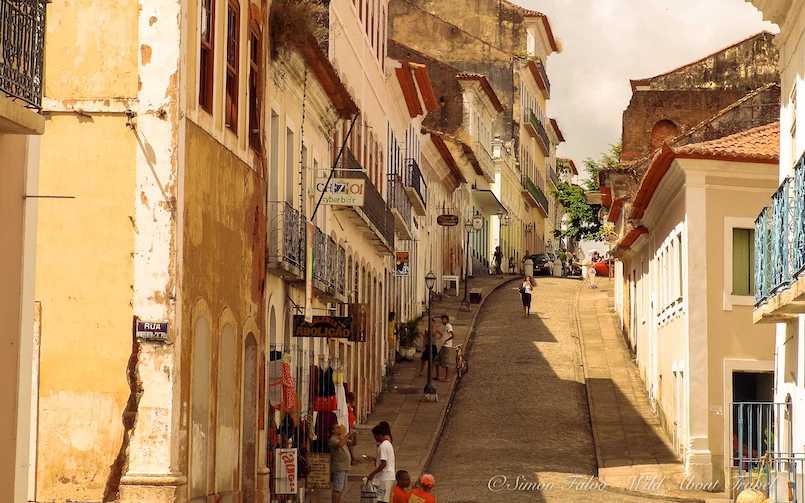
There was only a short time to explore the city, but the only evening I spent in São Luís was a blast. Walking around in the evening, I stumbled into street musicians at every corner. People were chatting and dancing. And the music was so enthralling that I joined the crowd and started dancing too.
In the morning, there was just enough time for a stroll in the old town. While I didn’t have high expectations, I liked the old colonial houses, many of which were decorated with colorful tiles, as a sign of the past Portuguese influence.
Where to stay in Sao Luis
Casa Frankie is a simple but cozy pousada in the historical center.
Casa Lavinia is a tastefully decorated guesthouse within walking distance from Sao Luis old town.
Check more hotels in Sao Luis.
2 weeks in Brazil: wrapping things up
Undoubtedly, spending 2 weeks in Brazil is a very short time for such a vast country. There’s much more to discover in Brazil besides this wild journey, primarily focused on northeastern Brazil. As I planned my Brazil itinerary, I knew that these were the places I longed to discover.
To me, these are some of the best places to visit in Brazil. But of course, I know that there’s much more to this incredible country, and I only got a taste of how much there still is to explore.
This post contains affiliate links to carefully selected products and services. That means I get a small commission at no extra cost to you if you make any purchase.
Pin for later!
